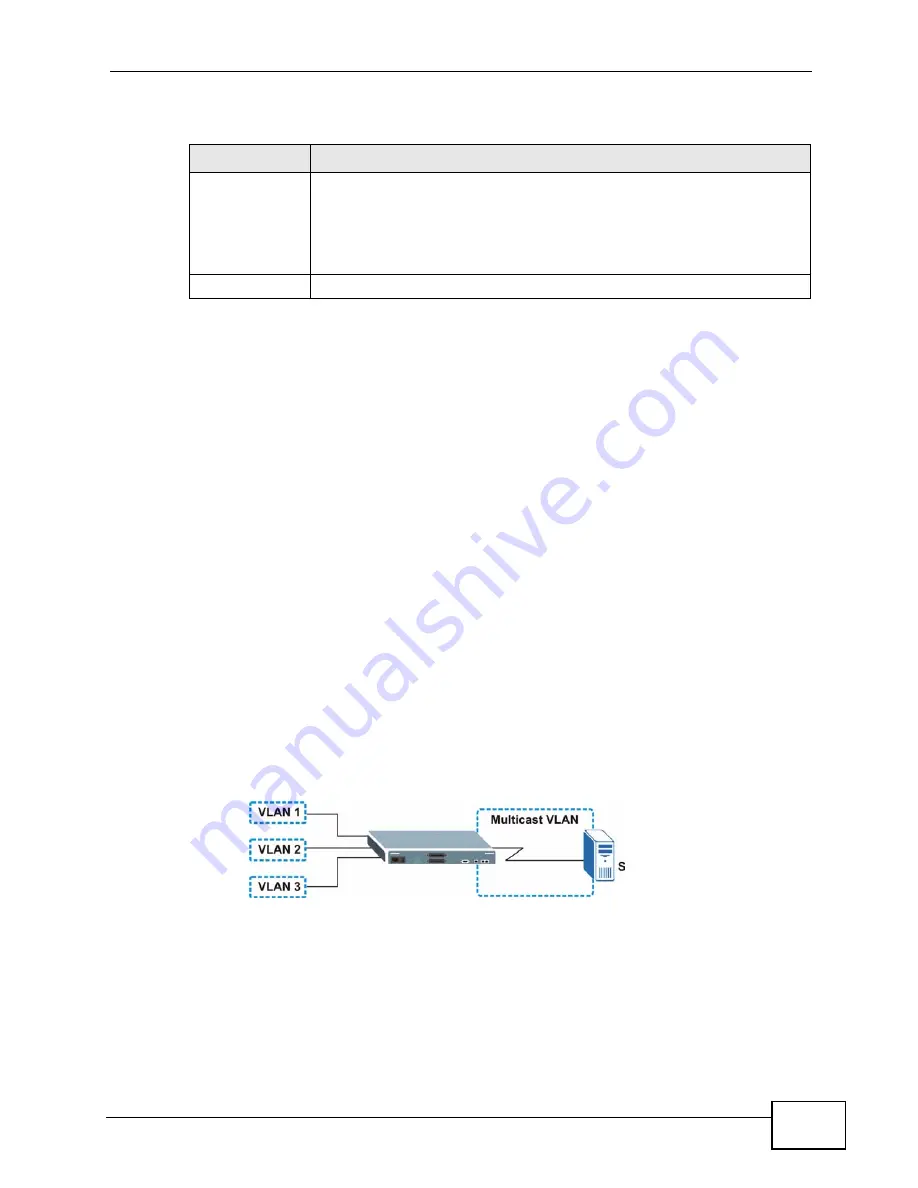
Chapter 24 Multicast
XGS-4728F User’s Guide
207
24.6 MVR Overview
Multicast VLAN Registration (MVR) is designed for applications (such as Media-on-
Demand (MoD)) that use multicast traffic across an Ethernet ring-based service
provider network.
MVR allows one single multicast VLAN to be shared among different subscriber
VLANs on the network. While isolated in different subscriber VLANs, connected
devices can subscribe to and unsubscribe from the multicast stream in the
multicast VLAN. This improves bandwidth utilization with reduced multicast traffic
in the subscriber VLANs and simplifies multicast group management.
MVR only responds to IGMP join and leave control messages from multicast
groups that are configured under MVR. Join and leave reports from other multicast
groups are managed by IGMP snooping.
The following figure shows a network example. The subscriber VLAN (1, 2 and 3)
information is hidden from the streaming media server, S. In addition, the
multicast VLAN information is only visible to the Switch and S.
Figure 106
MVR Network Example
24.6.1 Types of MVR Ports
In MVR, a source port is a port on the Switch that can send and receive multicast
traffic in a multicast VLAN while a receiver port can only receive multicast traffic.
Once configured, the Switch maintains a forwarding table that matches the
multicast stream to the associated multicast group.
Delete
To delete the profile(s) and all the accompanying rules, select the
profile(s) that you want to remove in the Delete Profile column, then
click the Delete button.
To delete a rule(s) from a profile, select the rule(s) that you want to
remove in the Delete Rule column, then click the Delete button.
Cancel
Click Cancel to clear the Delete Profile/Delete Rule check boxes.
Table 64
Advanced Application > Multicast > Multicast Setting > IGMP Filtering
Profile (continued)
LABEL
DESCRIPTION
Summary of Contents for XGS-4728F
Page 2: ......
Page 8: ...Safety Warnings XGS 4728F User s Guide 8 ...
Page 24: ...24 ...
Page 30: ...Chapter 1 Getting to Know Your Switch XGS 4728F User s Guide 30 ...
Page 34: ...Chapter 2 Hardware Installation and Connection XGS 4728F User s Guide 34 ...
Page 42: ...Chapter 3 Hardware Overview XGS 4728F User s Guide 42 ...
Page 44: ...44 ...
Page 78: ...Chapter 7 System Status and Port Statistics XGS 4728F User s Guide 78 ...
Page 92: ...Chapter 8 Basic Setting XGS 4728F User s Guide 92 ...
Page 94: ...94 ...
Page 114: ...Chapter 9 VLAN XGS 4728F User s Guide 114 ...
Page 118: ...Chapter 10 Static MAC Forward Setup XGS 4728F User s Guide 118 ...
Page 148: ...Chapter 14 Bandwidth Control XGS 4728F User s Guide 148 ...
Page 162: ...Chapter 17 Link Aggregation XGS 4728F User s Guide 162 ...
Page 186: ...Chapter 21 Policy Rule XGS 4728F User s Guide 186 ...
Page 230: ...Chapter 25 AAA XGS 4728F User s Guide 230 ...
Page 268: ...268 ...
Page 324: ...324 ...
Page 332: ...Chapter 38 Maintenance XGS 4728F User s Guide 332 ...
Page 358: ...Chapter 41 Syslog XGS 4728F User s Guide 358 ...
Page 366: ...Chapter 42 Cluster Management XGS 4728F User s Guide 366 ...
Page 370: ...Chapter 43 MAC Table XGS 4728F User s Guide 370 ...
Page 374: ...Chapter 44 IP Table XGS 4728F User s Guide 374 ...
Page 378: ...Chapter 46 Routing Table XGS 4728F User s Guide 378 ...
Page 382: ...382 ...
Page 392: ...Chapter 48 Troubleshooting XGS 4728F User s Guide 392 ...
Page 402: ...Chapter 49 Product Specifications XGS 4728F User s Guide 402 ...
Page 404: ...404 ...
Page 408: ...Appendix A Legal Information XGS 4728F User s Guide 408 ...
















































